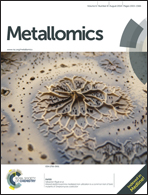Proteomic analysis of putative heme-binding proteins in Streptococcus pyogenes†
Abstract
Streptococcus pyogenes is an important human bacterium with high pathogenicity. Heme is a major source of iron that plays a critical role in bacterial survival and virulence. In this study, heme-affinity chromatography, two-dimensional-electrophoresis and mass spectrometry were combined to identify putative heme-binding proteins and heme-regulatory proteins. In total, 68 heme-regulatory proteins and 284 putative heme-binding proteins were identified, among which 37 proteins showed expression alterations in response to heme deficiency. Bioinformatics analysis revealed that several key metabolic pathways had changed in the absence of heme, among which glycolysis was a major pathway impaired under heme-deficient conditions. New potential heme-binding proteins were successfully identified in this study providing novel clues for the study of the heme transport mechanism. Heme-binding proteins may play fundamental roles in many important biological pathways and thus contribute to bacterial pathogenicity.


 Please wait while we load your content...
Please wait while we load your content...